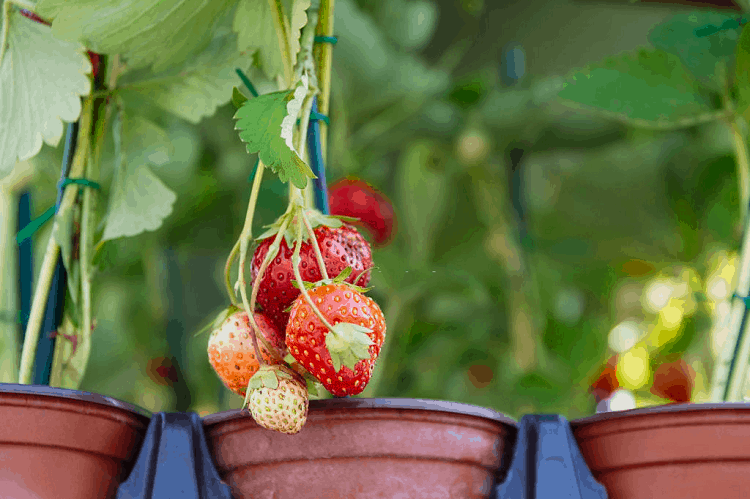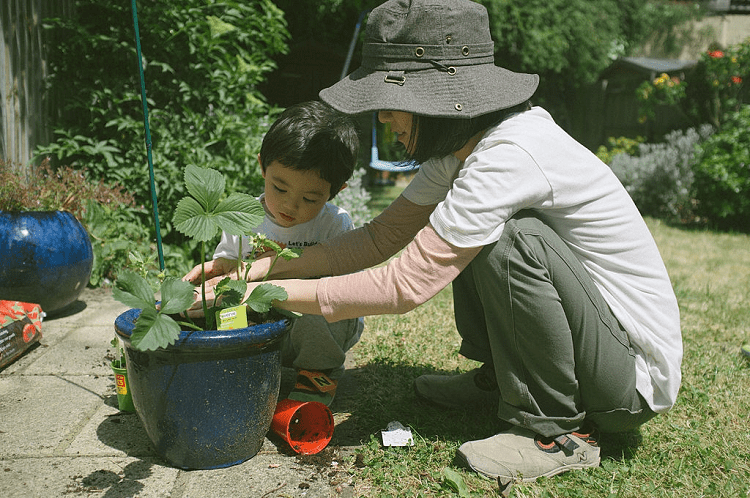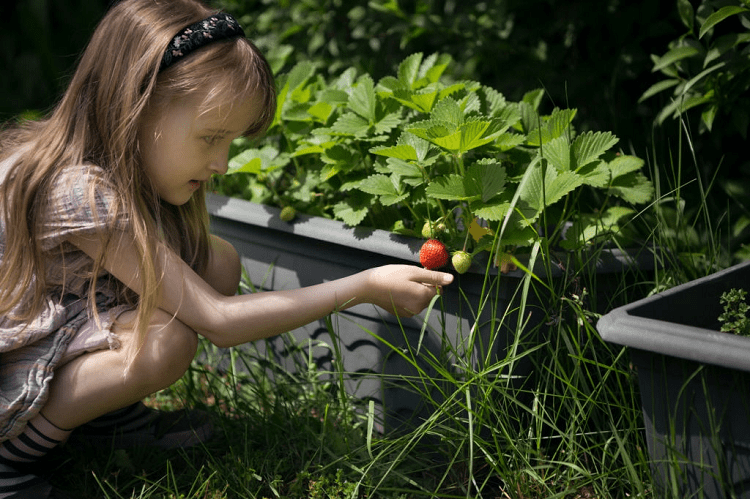Strawberries pretty much symbolize a lazy, warm summer period. If you love them as much as I do but have an issue of space, then growing strawberries in pots and containers couldn’t be easier.
It’s easy to grow strawberry plants in pots, thanks to their shallow roots. Strawberries only need a wide, shallow pot, fertile soil, and lots of sunlight to bloom. In today’s guide, we’ll look at how to grow strawberries in pots.
While growing strawberries in containers, ensure to monitor the plant carefully for signs of rot, pests, and fungus. And when it’s time to harvest the berries, prune flowers and runners gently to produce a more substantial, tastier bounty.
Finally, if you have limited space or you simply have a yearning to grow something uncommon, then growing strawberries in pots may be what you need.
Let’s now look at how to do this in 17 easy steps!
But first:
Table of Contents
Why Grow Strawberries In Pots?
Why not plant them straight in your garden?
To put succinctly, strawberry plants are compact and ideal for tucking in small spaces like pots, containers, baskets, and planters.
Growing them in pots is equally a fantastic way to foil pests, such as slugs that seem to grasp just when a strawberry is most sweet.
Additionally, strawberries grown in pots are generally less liable to fungal diseases and bacteria.
How To Grow Strawberries In Pots
1. Choose the right pot
Strawberry plants are small with shallow roots; as a result, your chosen pot should not be bottomless – it can be as little as 8 to 12 inches wide.
Don’t forget that little containers often dry out quickly; therefore, planting many strawberry plants in a larger pot will make it easier to care for them. You’ll want to space the plants 10 to 12 inches apart.
Furthermore, light-colored synthetic materials work well for this purpose. With the light color pot, the strawberry roots will remain cool all the time – and synthetic pots, like plastic, are good in retaining moisture, even better than clay pots.
You may see vase-shaped pot strawberry jars with pockets for plants as a natural choice; however, these often require special planting tactics that combine irrigation, which can result in a disappointing yield.
That said, you can also use hanging planters as well as a DIY – these are all great choices of pots for strawberry plants.
Another excellent idea will be to attach a cloth shoe rack against a wall (one with several pockets) for a vertical growing surface. Then add tiny holes beneath each pocket for water to pass through.
Bottom line: Whatever container you use to plant strawberries, good drainage is important.
2. Decide on the type of berry that you want
There are basically three types of cultivars. However, if the strawberry plants you want to grow do not show the kind, ask for assistance, or research it online.
- June-bearing strawberry plants yield a flush of berries in the spring season, but only once during the growing period. These can give you a plentiful harvest.
- Everbearing strawberries produce fruits in 2 to 3 flushes across the summer seasons, giving you a lengthier growing period to enjoy the delicious fruit.
- Day-neutral berries can stop flowering when temperatures rise to over 85 degrees Fahrenheit. So, this type of strawberry is not ideal in regions with severe hot summers.
- Day-neutral is a newer version of everbearing strawberries. These plants will continually yield fruit when temperatures remain between 35 to 85 degrees Fahrenheit. In mild regions, day-neutral plants can keep on producing well into fall.
3. Use a loose, well-draining soil
Once you’ve chosen your strawberry pot, fill it with a loose, loamy potting mix with high water retention ability, but will discharge any excess. Go for a soil that holds moisture but doesn’t become damp.
4. Choose the right spot for the plant
Sun-loving berries grow best in 6 or more hours of direct sun per day. In the United States regions that have the highest heat, a plant may need some light shade all through the day.
However, if you reside in a dry region, misting around the container can equally help the plants resist heat. For even exposure, you’ll want to rotate the container every 2 to 3 days.
Set the container in an area that receives nothing less than 6 hours of sun per day to ensure ample fruits and flowers. But if the sunlight comes from one direction only, then if possible, rotate the pot every 3 to 4 days.
Besides, ensure that the plants are well protected: The fact that the berries are in containers does not mean that pests can’t attack them. Your plants will still attract birds, insects, and other climbing creatures, so protect them with fencing or netting, if necessary.
Read Also: How to Grow Spinach in Pots
5. Fill the pot with compost or potting mix
Use compost or a premixed potting soil that has a pH between 5.5 and 6.5. Fill up the container to 1 inch (2.5 cm) below the top – or thereabouts.
For bulky and large containers, load the bottom of the container with little ceramic pieces or rocks. Then place landscaping fabric over it before filling it with soil. This will ensure the proper draining of the pot.
Besides that, it will equally make the container lighter than it would be if you completely filled it with soil, enabling you to move it if required.
Avoid using soil from your backyard as it may not be easy to drain – and it may not be the perfect pH for strawberries.
6. Transplant the strawberry plants into the container
Drill a hole deep enough for the roots of your strawberry. Its current nursery container can be used as a guide. Remove the plant from the container and put them inside the hole. Use dirt to cover the roots – and then water the soil around the berries.
The top of the roots should sit underneath the surface of the soil, while the thickened, green stem (known as the crown) should sit directly above it.
7. Water the plants with care
You want to prevent the strawberry plants from drying out, while also avoiding saturated soil, which can lead to rot. Since strawberry has shallow roots, there’s no need to water a deep container until water discharges from its bottom.
When summer is at its peak, a lighter watering twice daily may be ideal. Direct water beneath the plant’s leaves and do not let water stand on the leaves.
Furthermore, you want to water the plants early in the day or later in the noon with enough time for the water to pass through and dry off the plant before sunset.
8. Fertilize your strawberry plant regularly
Feed the plant weekly with a liquid fertilizer that is high in potassium to increase fruit production or with a balanced 10-10-10 (or its organic equivalent) for the general health of the plant. After the application, brush granules off the leaves.
9. Protect the plant from winter and disease
Once the fruits start to develop, carefully raise them from the ground by tucking wood chips or straw beneath. This reduces the risk of disease to a great extent.
Strawberry plants yield best if you allow them to go dormant in the winter. But the roots may freeze in colder/frosty areas, and some pots will even crack if kept in freezing temperatures.
However, you can move your pots under a deck or into an unheated garage for the season. It’s also important to water only when the soil gets extremely dry. You might be able to mulch up and around the pot and leave it in place.
10. Protect the containers from windy settings
Wind can dehydrate the soil and knock the containers over, harming your berries. If your place of residence gets windy, keep the containers against a deck, shed, or fence. Or you can also place stakes around the container to keep it in place.
11. Kill pests with insecticides
If you discover holes on the strawberry leaves, nibbled berries, or discolored leaves, then pests may be feeding on your plants.
Interestingly, products that contain neem or insecticidal soaps are very effective against beetles, caterpillars, and thrips. Remember to read the instructions on the label and follow it while using it.
For most pesticides, spray it onto the leaves directly, either late in the evening or early morning.
And if birds are also feeding on your berries, drape a mesh or net over the plant to ward them off.
12. Use a fungicide to kill fungus
Strawberry plants can develop fungus pretty quickly. You may notice discoloration or powdery spots on the leaves – simply buy a fungicide from a garden store or nursery.
Ensure that the product is labeled as safe for strawberries before using it. Again, read the instructions on the label before using it.
Keep potted strawberries away from eggplants, tomatoes, and potatoes. These plants are common carriers of fungus that can easily extend to strawberries.
Additionally, watering the base of the strawberry and not the leaves can also help to prevent fungus growth. And if you notice any leaves affected by fungus, remove it immediately to prevent it from getting to other parts of the plant.
13. Decide between perennial or annual
Growing strawberry plants in containers as annuals is the most relaxed way to enjoy them. Just remove the plants at the end of summer or after fruiting and start all over in the new year.
However, if you prefer to keep your plants for one more season or two, then keep on fertilizing after harvest. Snap off any runners that come up and prune the plants back to the center to focus your energy entirely on developing the plant.
If you have mild winters, then you may be able to shelter the berries in place by adequately mulching with sawdust or straw. Placing the containers close to the outside of a house can also create a warmer climate.
If you leave in colder regions, either overwinter the plants in an unheated garage or dig the pot into the soil. You can also grow the plants under plastic row cover. Water enough to prevent the plant from drying out.
Another great benefit of sustaining strawberry plants across winter is that they produce more fruit their second year, so a pleasant harvest lies ahead.
Read More: Mulching and It's Advantages
Encouraging Strawberry Harvest
14. Remove the flowers that appear in the first year
Cut off these flowers to miss the first harvest and yield a stronger second harvest. And if you have an everbearing or day-neutral variety, pluck the flowers until the end of June to harvest in the fall.
However, if you have a June-bearing type, cut all flowers off in the first year.
15. Add new compost or soil to the container in spring
Since containers cannot get nutrients from the ground, it is essential to refill the soil in the container yearly. The best months to do this are in March or April.
If you’re using small pots, such as hanging baskets or window boxes, replace the soil completely. Gently remove the strawberry from the container, being careful not to interrupt the roots. Then throw away any remaining soil, replacing it with fresh potting soil.
Besides, if you’re making use of a large growing bed or pot, simply mix fresh compost into the soil’s top layer in the pot. There’s no need to replace all the soil.
16. Remove runners (except you want to grow new strawberry plants)
Your berries will develop long, leafless vines. Roots and seedlings will grow from these runners to grow new plants; however, they will equally divert energy away from your strawberry production. Therefore, you’ll want to cut off these runners using a pair of gardening shears.
But you can keep the runners if you choose to grow new plants. Pin the little plantlet on the stalk into the soil with a piece of wire or a hairpin. And once it grows leaves, detach it from the mother plant and transfer it to a separate pot.
17. Harvest your berries when they generally turn red
All strawberries should be harvested when they ripen. Do not leave any rotting strawberries on the bush. To pick your berries, just twist the stem off the plant – and remember to wash the fruits thoroughly before eating.
Growing Strawberries in a Container | Conclusion
As you can see, growing strawberry plants in pots aren’t really that difficult. You just have to follow the general principles as outlined here, and pay special attention to the tips and cautions mentioned.
If you do everything as described, there is absolutely no reason your container strawberries can’t grow and yield just as in-ground strawberry plants.
Just pay more attention to the little fellows more than you would the strawberries planted in a garden. I hope by now, you already know how to grow strawberries in pots.
Congratulations!








Leave a Reply